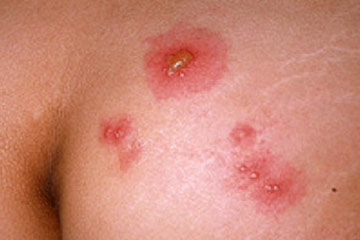Guideline Gastroesophageal Reflux Disease
Guideline Objective(s)
To implement a cost-effective and evidence-based strategy for the diagnosis and treatment of gastroesophageal reflux disease (GERD)
Target Population
Adults with suspected or confirmed gastroesophageal reflux disease (GERD)
Interventions and Practices Considered
Diagnosis/Evaluation
- History (signs, symptoms)
- Testing
- Esophageal pH monitoring
- Endoscopy
- Barium radiology (considered but not recommended)
- Esophageal manometry
Anuncios - Empiric/therapeutic trials of anti-secretory therapy
Treatment/Management
- Lifestyle modifications
- Pharmacologic treatment
- Histamine type-2 receptor antagonists (H2RAs)
- Proton pump inhibitors (PPIs)
- Supplemental acid-neutralizing agents
- Over-the-counter (OTC) remedies
- Anti-reflux surgery
- Alternative endoscopic treatments (radiofrequency heating of the gastroesophageal junction, endoscopic gastroplasty, polymer injections and full thickness gastroplication)
- Maintenance regimens
- Step-up therapy
- Step-down therapy
- On-demand therapy
- Follow-up
- Referral to gastroesophageal reflux disease (GERD) specialists
- Further diagnostic testing (e.g., esophagogastroduodenoscopy (EGD), pH monitoring) for those non-responsive to acid suppression therapy or at risk for complications
- Special considerations for older adults, pregnant patients, and atypical manifestations of GERD
- Screening and treatment for Barrett's esophagus
- Treatment of Helicobacter pylori infection (not recommended as treatment for GERD)
Major Outcomes Considered
- Sensitivity and specificity of diagnostic tests
- Rate of symptomatic relief
- Esophagitis healing rates
- Medication and treatment side effects
- Cost-effectiveness of treatment
Major Recommendations
Note from the National Guideline Clearinghouse (NGC): The following key points summarize the content of the guideline. Refer to the full text for additional information, including detailed information on dosing, possible side effects, and cost of medications.
The strength of recommendation (I-III) and levels of evidence (A-D) are defined at the end of the "Major Recommendations" field.
Diagnosis
- History. If classic symptoms of heartburn and acid regurgitation dominate a patient’s history, then they can help establish the diagnosis of gastroesophageal reflux disease (GERD) with sufficiently high specificity, although sensitivity remains low compared to 24-hour pH monitoring. The presence of atypical symptoms (see table below), although common, cannot sufficiently support the clinical diagnosis of GERD [B].
Table. Atypical Signs of GERD
Chronic cough Asthma Recurrent sore throat Recurrent laryngitis Dental enamel loss Subglottic stenosis Globus sensation Chest pain Onset of symptoms at age >50 Anuncios |
- Testing. No gold standard exists for the diagnosis of GERD [A]. Although pH probe is accepted as the standard with a sensitivity of 85% and specificity of 95%, false positives and false negatives still exist [II B]. Endoscopy lacks sensitivity in determining pathologic reflux but can identify complications (e.g., strictures, erosive esophagitis, Barrett's esophagus) [I A]. Barium radiography has limited usefulness in the diagnosis of GERD and is not recommended [III B].
- Therapeutic trial. An empiric trial of anti-secretory therapy (AST) can identify patients with GERD who lack alarm/warning symptoms (see table below) [I A] and may be helpful in the evaluation of those with atypical manifestations of GERD, specifically non-cardiac chest pain (NCCP) [II B].
Table. Alarm/Warning Signs Suggesting Complicated GERD
Dysphagia Odynophagia Gastrointestinal (GI) bleeding Iron deficiency anemia Weight loss Early satiety Vomiting |
Treatment
- Lifestyle modifications. Lifestyle modifications (see table below) should be recommended throughout the treatment of GERD [II B], yet there is evidence-based data to support only weight loss and avoiding recumbency several hours after meals [II C].
Table. Lifestyle Modifications
Elevate head of bed 6-8 inches Decrease fatty meals Stop smoking Avoid recumbency/sleeping for 3-4 hours postprandially Avoid certain foods: chocolate, alcohol, peppermint, caffeinated coffee and other beverages, onions, garlic, fatty foods, citrus, tomato Avoid large meals Weight loss Avoid medications that can potentiate symptoms: calcium channel blockers, β-agonists, α-adrenergic agonists, theophylline, nitrates, and some sedatives (benzodiazepines) |
- Pharmacologic treatment. H2-receptor antagonists (H2RAs), proton pump inhibitors (PPIs), and prokinetics have proven efficacy in the treatment of GERD [I A]. Prokinetics are as effective as H2RAs but are currently unavailable [III A]. Carafate and antacids are ineffective [III A], but may be used as supplemental acid-neutralizing agents for certain patients with GERD [II D].
- Non-erosive reflux disease (NERD): Step-up (H2RA then as followed by a PPI if no improvement) and step-down (PPI then followed by the lowest dose of acid suppression) therapy are equally effective for acute treatment and maintenance [I B]. On demand (patient-directed) therapy is the most cost-effective strategy [I B].
- Erosive esophagitis: Initial PPI therapy is the treatment of choice for acute and maintenance therapy for patients with documented erosive esophagitis [I A].
- Take PPI's 30-60 minutes prior to breakfast (and dinner if two times per day [BID]) to optimize effectiveness [I B]. Use generic and over-the-counter (OTC) formulations exclusively, eliminating need for prior authorizations.
- Patients should not be left on AST without re-evaluation of symptoms to minimize cost and the potential adverse events from medications [I B].
- Surgery. Anti-reflux surgery is an alternative modality in GERD treatment for patients with chronic reflux and recalcitrant symptoms [II A], yet has a significant complication rate (10-20%). Resumption of pre-operative medication treatment is common (>50%) and may increase over time.
- Other endoscopic modalities. While less invasive and with fewer complications, they have lower response rates than anti-reflux surgery [II C], and have not been shown to reduce acid exposure.
Follow up
- Symptoms unchanged. If symptoms remain unchanged in a patient with a prior normal endoscopy, repeating endoscopy has no benefit and is not recommended [III C].
- Warning signs. Patients with warning/alarm signs and symptoms suggesting complications from GERD (see table above) should be referred to a GERD specialist.
- Risk for complications. Further diagnostic testing (e.g., EGD [esophagogastroduodenoscopy], pH monitoring) should be considered in patients who do not respond to acid suppression therapy [I C] and in patients with a chronic history of GERD who are at risk for complications. Chronic reflux has been suspected to play a major role in the development of Barrett's esophagus, yet it is unknown if outcomes can be improved through surveillance and medical treatment [D].
Definitions:
Levels of Evidence
- Randomized controlled trials
- Controlled trials, no randomization
- Observational trials
- Opinion of expert panel
Strength of Recommendation
- Generally should be performed
- May be reasonable to perform
- Generally should not be performed
Benefits/Harms of Implementing the Guideline Recommendations
Potential Benefits
Accurate diagnosis and appropriate, cost-effective treatment of gastroesophageal reflux disease (GERD)
Potential Harms
- H2 receptor antagonists (H2RAs) have been associated with rare cytopenias, gynecomastia, liver function test abnormalities, and hypersensitivity reactions. In the long-term, there have been no controlled trials with follow-up on the safety of chronic use of H2RAs. Cimetidine may cause gynecomastia or androgenic side effects, and may interact with medications metabolized by cytochrome P450.
- The potential benefit of chronic proton pump inhibitor (PPI) therapy in patients with chronic or complicated gastroesophageal reflux disease (GERD) generally outweighs any theoretical risk of adverse events. Risks associated with chronic PPI therapy include Clostridium-difficile-associated diarrhea (adjusted odds ratio [AOR] = 2.1 – 2.6); community-acquired pneumonia (AOR = 1.5 – 1.9); bone fracture (AOR = 1.4 – 1.6); vitamin B12 deficiency (AOR = 1.0 – 4.46); antiplatelet interactions (AOR = 1.25). Data regarding risks of bone fracture and antiplatelet interactions are controversial. A recent U. S. Food and Drug Administration (FDA) warning recommends periodic surveillance of serum magnesium levels due to potential hypomagnesiumia. Since all data were collected retrospectively, a definitive cause-and-effect relationship cannot be proven. All patients on long-term PPI therapy should be re-evaluated periodically to determine need and to weigh potential risks versus benefits of therapy.
- Controlled trials comparing open and laparoscopic approaches have shown similar efficacy and complications with lower morbidity and shorter hospital stays in the laparoscopic repair group. Post-surgical complications are common, but typically short term and manageable in most instances. Short-term solid food dysphagia occurs in 10% of patients (2% to 3% have permanent symptoms) and gas bloating occurs in 7% to 10% of patients. Diarrhea, nausea and early satiety occur more rarely. While some complication occurs in up to 20% of patients, major complications occur in only 3% to 4% of patients.
| University of Michigan Health System. Gastroesophageal reflux disease (GERD). Ann Arbor (MI): University of Michigan Health System; 2012 May. 12 p. [11 references] |
Source
Gastroesophageal reflux disease (GERD)
National Guideline Clearinghouse






